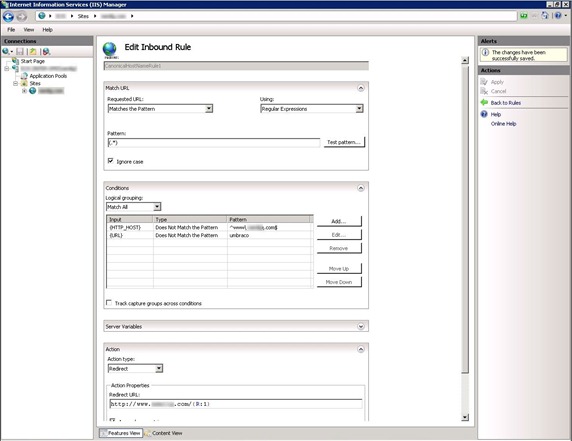by DotNetNerd
10. June 2010 20:35
This week I ran into a problem when we were deploying a webapplication that uses ajax-enabled webservices to an environment that uses loadbalancing. The services were running fine in the stage environment and when each of the servers were called directly, but as soon as we went through the loadbalancer they failed.
I started by checking if the svc files could be reached, and surely enough they could be accessed from the servers, but through the loadbalanced domain I got a 404.
Reading blogposts on the subject provided little help – well actually it just hightened my degree of confusion. So after some time I started thinking about IIS bindings. I remembered that I had written a custom WebScriptServiceHostFactory because we had several bindings which IIS doesn’t handle too well.
using System;
using System.Configuration;
using System.ServiceModel;
using System.ServiceModel.Activation;
namespace MySite.ScriptingService
{
public class MyCustomHostFactory : WebScriptServiceHostFactory
{
protected override ServiceHost CreateServiceHost(Type serviceType, Uri[] baseAddresses)
{
//This makes it possible to control which binding is used by sorting them in IIS.
return new ServiceHost(serviceType, baseAddresses[int.Parse(ConfigurationManager.AppSettings["BindingIndex"] ?? "0")]);
}
}
}
I started playing around with which binding we used, and as I suspected if the binding was not the one for the loadbalanced domain it returned the 404. This was one of those “doh!” moments. I still had a problem though, because the site could be accessed both with and without the www subdomain. A colleague pointed to the fact that we could use the URL rewrite plugin for IIS, and have it ensure all traffic was directed through one of the domains. As it turnes out it actually has a CanonicalHostNameRule that does just this because its a SEO good practice. Only issue I had left was that umbraco on the other hand has a practice that it must be accessed directly on one server, so changes are made on the master and replicated to the slave(s). This just required extending the conditions so it does not redirect if the umbraco folder is part of the path.

So now by posting this I hope Ill save someone else from getting a few extra gray hairs, and if not maybe I’ll save my self some other time when I can’t remember how I did…
by DotNetNerd
24. June 2009 13:28
Today I experienced an issue with Server.MapPath which returned a path under inetpub/wwwroot, instead of returning the path relative to where my app was published. After a while I resolved to uncle google and found out that IIS apparently returns the path relative to the "Default Web Site" instead of relative to the actual site when the path is parallel to the sites physical path. I was kind of puzzled that I hadn't come accross this before, because it seems like something that would be a recurring issue. By noteing it here I hope to have it as a reminder for myself as well as it being a help to others, who might avoid pulling out a few hairs.
Lately I have had a few requests to start writing in english, so as of today my posts will be written in english. I am hoping this will make my blog more usefull, and that it might result in more comments :-)
by DotNetNerd
16. December 2007 14:50
Jeg opdagede idag at det er knap så "lige ud af boksen" som man kunne ønske sig at afvikle ASP.NET og Windows Communication Foundation services under Vista og IIS 7. Man kan kun undre sig over at ihvertfald ASP.NET ikke automatisk installeres ved installation af IIS, men det er åbenbart ikke tilfælder. Det lykkedes dog efter at have rodet lidt at få det til at virke og jeg vil derfor lige skrive en guide hvis andre skulle støde på samme problem.
Installation af IIS og ASP.NET på Windows Vista
For at kunne afvikle en ASP.NET applikation skal man først installere IIS og den tilhørende ASP.NET komponent. Dette kræver administrator rettigheder og gøres ellers ved at:
-
Gå til kontrolpanel -> Programmer og funktioner.
-
Herfra vælger du "Slå windows funktioner til eller fra" i sidemenuen til venstre i vinduet.
-
Vælg internet Information Service og udvid punktet.
-
Udvid "værktøjer til webmanagement" og "kompatibilitet med IIS 6 management".
-
Vælg "Kompatibilitet med IIS-metabase og IIS 6-konfiguration".
-
Udvid også "World wide web services" og Funktioner til programudvikling.
-
Vælg ASP.NET checkboksen.
Du kan nu afvikle ASP.NET applikationer ved at oprette dem på almindeligvis via IIS management værktøjet - eller bruge default sitet ved at smide det i inetpub/wwwroot.
Installation af WCF service modellen
For at kunne afvikle en Windows Communication Foundation service skal service modellen registreres.
Dette gøres ved at:
-
Åben en kommandoprompt med admin rettigheder.
-
Gå til %Windows%\Microsoft.Net\Framework\v3.0\Windows Communication Foundation\
-
Check status ved at skrive ServiceModelReg -vi og se om service modellen allerede er installeret.
-
Er den ikke installeret skriv ServiceModelReg -i og så skulle modellen blive installeret.
Og nu kan du så også afvikle en Windows Communication Service.
Lige for en god ordens skyld skal det siges at for at hoste en WCF service under IIS 7 skal man blot smide en svc fil med følgende indhold i roden af sitet.
<%@ ServiceHost Language="C#" Debug="true" Service="Syndication.FeedService" %>
Hvor servicen skal pege på klassen der implementerer din service. Dll'en skal ellers bare ligge i en bin mappe som den plejer.